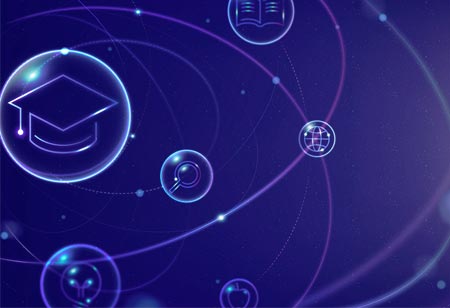THANK YOU FOR SUBSCRIBING
Be first to read the latest tech news, Industry Leader's Insights, and CIO interviews of medium and large enterprises exclusively from Education Technology Insights
Enhancing Student Engagement Through Social Media
In today's higher education landscape, college and university professors, instructors, and faculty members are facing the challenge of effectively utilising social media to engage their students.

By
Education Technology Insights | Tuesday, May 30, 2023
Stay ahead of the industry with exclusive feature stories on the top companies, expert insights and the latest news delivered straight to your inbox. Subscribe today.
Social media offers opportunities for increased student engagement through gamification, peer interaction, knowledge sharing, showcasing achievements, and fostering motivation and collaboration.
FREMONT, CA: In today's higher education landscape, college and university professors, instructors, and faculty members are facing the challenge of effectively utilising social media to engage their students. Due to the Covid-19 pandemic, educational institutions are seeking ways to leverage technology tools that truly resonate with their student body.
Utilising Gamification Techniques: Gamification is a demonstrative approach that utilises game elements and mechanics to motivate and engage students. Integrating gamification techniques into social media platforms transforms learning into an interactive and enjoyable experience. The following ways educators leverage gamification on social media to boost student engagement:
Leaderboards and Challenges: Creating leaderboards and challenges within social media groups or pages encourages healthy competition among students. For instance, educators design quizzes or knowledge challenges related to the course content and award points or badges to those who actively participate and perform well. This approach not only incentivises student engagement but also fosters a sense of achievement and recognition.
Interactive Polls and Surveys: Social media platforms provide various tools for conducting polls and surveys. Educators utilise these features to gather student opinions, preferences, and feedback. By incorporating polls and surveys in real-time, instructors capture students' attention, prompt critical thinking, and encourage active participation. These interactive elements enable educationalists to tailor the learning experience based on student feedback, creating a sense of ownership and personalisation.
Collaborative Games and Challenges: Collaborative games and challenges promote teamwork and cooperation among students. For instance, educators organise online scavenger hunts, where students work together to solve puzzles or find specific information. Social media groups or pages serve as a platform for students to discuss strategies, share resources, and celebrate their achievements. Such activities cultivate a sense of community and foster peer-to-peer learning, leading to increased engagement and motivation.
Encouraging Peer Interaction and Knowledge Sharing
The world of social media offers opportunities for students to interact with their peers, exchange ideas, and collaborate on projects beyond the confines of the physical classroom. Here are some ways that teachers utilise social media platforms to encourage peer interaction and facilitate the sharing of knowledge:
Discussion Forums and Groups: Creating dedicated discussion forums or groups on social media platforms enables students to engage in meaningful conversations and debates related to course topics. Educators facilitate these platforms by posing thought-provoking questions, sharing relevant articles or resources, and providing guidance when needed. By encouraging students to actively participate in these online discussions, educators foster a sense of community and empower students to take ownership of their learning.
Collaborative Projects and Presentations: Students can use social media platforms to collaborate on projects and presentations. Educators can assign group projects and create private groups on social media platforms, where students collaborate, brainstorm ideas, and share their progress. Students use multimedia features such as videos, images, and documents to enhance their presentations. This collaborative approach nurtures teamwork, communication skills, and critical thinking while increasing student engagement through active participation.
Peer-to-Peer Feedback and Mentoring: Internet community assist with peer-to-peer feedback and mentoring processes. Educators encourage students to provide constructive feedback on their peers' work, fostering a culture of collaboration and continuous improvement. By incorporating feedback mechanisms such as comments, likes, and shares, social media platforms allow students to receive immediate validation and support from their peers. This interactive feedback loop motivates students to actively engage with their peers' work and enhances the learning experience.
Showcasing Student Achievements and Creativity: Students can showcase their achievements, creativity, and projects to a broader audience on their social media handles. By sharing and celebrating students' work, educators cultivate a sensation of pride and motivation, thus increasing student engagement. Here are three ways to leverage social media for showcasing student achievements:
Student Portfolios and Showcase Pages: Creating individual or group portfolios on social media platforms allows students to curate and exhibit their best work. These portfolios are shared within a private group or made publicly accessible, enabling students to receive feedback and recognition from a wider audience. This platform not only boosts student motivation but also facilitates reflection and self-assessment.
Hashtag Campaigns and Challenges: Educators create hashtag campaigns or challenges on social media platforms, encouraging students to share their achievements or creative work. For instance, a specific hashtag can be assigned to a project or assignment, and students can upload their work using that hashtag. This approach not only promotes creativity and healthy competition but also allows students to inspire and learn from each other's accomplishments.
Virtual Exhibitions and Events: Social media platforms can be utilised to organise virtual exhibitions and events where students can showcase their work to peers, parents, and the broader community. These virtual showcases can include multimedia presentations, live demonstrations, and interactive Q&A sessions. By leveraging social media as a platform for these events, educators can create a sense of pride, engagement, and appreciation among students.
Building Relationships with Campus Influencers
One strategy that many schools overlook is leveraging relationships with influential individuals on campus, commonly referred to as influencers. Reaching out to these influencers is usually straightforward, as they often need to be more accustomed to being approached by higher education institutions. Many students have their email addresses listed in their social media bios or on their YouTube channels. However, it is crucial to approach them genuinely and show interest in their work before exploring potential collaborations. From the influencers' perspective, it is advisable to find ways to compensate them, regardless of their follower count.
Social media tenets offer a vast array of opportunities to increase student engagement in the learning process. By leveraging gamification techniques, encouraging peer interaction and knowledge sharing, and showcasing student achievements, educators can create dynamic and interactive learning environments. When effectively implemented, these strategies enhance student motivation, foster collaboration and creativity, and cultivate a sense of ownership and pride in their learning journey. As social media continues to evolve, educators must adapt their approaches to harness its potential and maximise student engagement.







